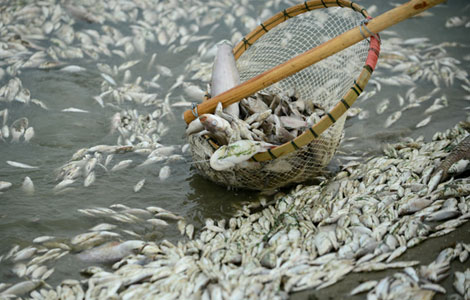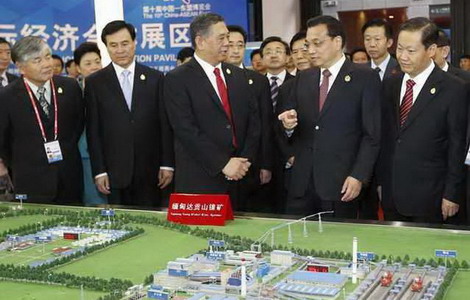

Ladies and gentlemen!
The international situation continues to undergo complex and profound changes at present. There are some positive signs in the economy of developed countries, and emerging economies and developing countries have shown great potentials in market expansion. These are favorable and positive factors. Meanwhile, the world economy is in in-depth adjustment, and the global economic recovery is facing a lot of uncertainties and unstable factors. The profound impact of the international financial crisis has not ended, with structural contradictions, including out-of-control crisis, growth and North-South imbalances, remain outstanding. To deal with difficulties and challenges faced by different countries, development is the essential resolution.
Asia, which has nearly half of the world's population and one-third of the global economy, has created a series of growth miracles. It has become one of the most vigorous regions of world economic development in recent years. But we also need to notice that development among Asian countries remain uneven, and the task of promoting growth and improving people's well-being is arduous. Recently, capital flows and financial markets in some emerging economies and developing countries have been influenced sharply due to the increasing expectations that some developed countries, major reserve currency issuing countries in particular, might withdraw from the quantitative easing monetary policies. Some Asian countries are among those affected, facing multiple challenges such as outflow of capital, currency devaluation, slower growth and rising inflation, which have aroused concerns from people and some friendly countries. Under the current circumstances, the major task of China and the ASEAN remains to develop their economy and improve people's well-being. We should adhere to the guideline of giving priority to the economies, development and people's well-being. We should focus our attention to those three aspects and keep advocating the spirit of unity and cooperation, as well as helping each other. We should also join hands to deal with possible and unforeseeable risks and challenges, and strive to keep the economy running smoothly and healthily. This is a common interest for all sides, and also for their people.
Ladies and gentlemen!
China and the ASEAN have achieved significant progress in the past decade under the meticulous cultivation by leaders of each countries. The two sides have witnessed a golden decade of China-ASEAN cooperation, with bilateral trade volume increasing by fivefold and the scale of two-way investment expanding threefold. We built up the largest free trade area of the developing countries across the world, which conform to the trend of development and bring benefits to the people. The ASEAN has already become the third largest trade partner of China. The economic connection between China and the ASEAN has never been so close and interdependent as today.
China and the ASEAN are natural partners. We are in the same phase featured by accelerating industrialization and urbanization, and we have similar development goals and tasks. Pushing China-ASEAN economic cooperation and development will definitely unleash enormous vitality. During these couple of days, I have held wide-ranging and profound exchanges with leaders of the ASEAN countries and we reached a series of important consensus. We unanimously agreed that our common interests are expanding. We had the capabilities to create a "golden decade" in the past, we also have the power to create a "diamond decade" in the future. We need to carry forward the cause pioneered by our predecessors and forge ahead into the future. Standing at a new starting point in history, we should seek new strategic breakthroughs, constantly deepen pragmatic cooperation, and work together to upgrade the level of China-ASEAN cooperation on the basis of enhancing political mutual trust and promoting the spirit of openness and inclusiveness, so as to promote the advancement of the bilateral strategic partnership. Hence, I raise the following proposals for cooperation:
The first is to create an upgraded version of the China-ASEAN Free Trade Area. The establishment of the China-ASEAN Free Trade Area has created a precedent for trade and investment cooperation in the Asia-Pacific region, which greatly boosted the rapid development of bilateral economic and trade relations. Looking into the future, China will uphold traditions in the establishment of the free trade area over the past ten years, prioritize the ASEAN's representation of their interests, and create more favorable conditions for ASEAN's development. We are willing to upgrade and expand the content and scope of China-ASEAN free trade area agreement based on the principles of mutual benefit and common development. Both sides can consider deepening talks on further lowering tariff rates, cutting non-tariff-related measures, launching dialogues for a new round of service trade pledge, and pushing forward the actual opening-up for investment through policies concerning access and personnel travels, so as to boost the liberalization and facilitation of trade and investment. This will enable the China-ASEAN Free Trade Area keep up with the times and make it into an upgraded version covering more areas and with higher quality. We are willing to sign long-term trade agreements for agricultural products with the ASEAN, actively expand the imports of ASEAN products that are competitive and appealing to the Chinese market. We aim to expand bilateral trade volume to one trillion U.S. dollars by 2020, meanwhile, increase bilateral investment by 150 billion dollars during the next eight years. Just as the ASEAN is the priority in China's peripheral diplomacy, the ASEAN is also the priority of China's outbound investment. We also welcome enterprises in the ASEAN countries to invest and start businesses in China.
Meanwhile, China is willing to join hands with the ASEAN to advance talks of Regional Comprehensive Economic Partnership (RCEP), and discuss exchanges and interactions with frameworks such as Trans-Pacific Partnership (TPP) Agreement, so as to create an open, inclusive and mutually beneficial climate to "make the two wheels of regional and global trade roll together".







